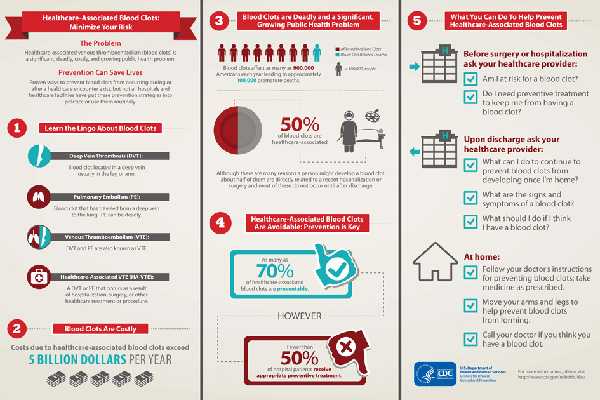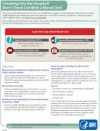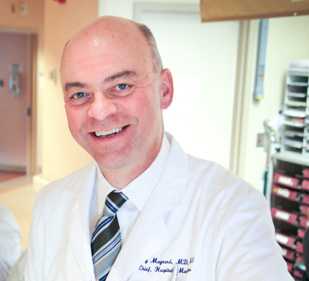HA-VTE Resources
HA-VTE Infographic

Fact Sheet

Checking into the Hospital? Don’t Check Out With a Blood Clot! Fact Sheet
Did you know that getting a blood clot from a hospitalization, surgery, or other healthcare treatment or procedure (called healthcare-associated venous thromboembolism or HA-VTE for short) is a significant, costly and growing public health problem? It is! But it is also preventable! Become familiar with the terminology used to discuss blood clots. Learn the facts about HA-VTE and what you can do to prevent it from happening to you or someone you care about.

Prevention Plan Checklist
Did you know that a hospitalization, surgery, or other healthcare treatment increases your risk for a blood clot? Learn what steps you can take to protect yourself.
Hospitalization Risks
Learn more about hospitalization and the increased risk for blood clots.
Checklist for Risk Factors
Learn more about common risks for blood clots.
NBCA Online Curriculum
Stop the Clot®: What Every Healthcare Professional Should Know: This self-paced, online course provides the most current foundational information on assessing, treating, and managing patients who have blood clots and clotting disorders. The target audience for this online curriculum is physicians, pharmacists, nurses, nurse practitioners, physician assistants, and other interested healthcare professionals.
CDC Grand Rounds: Preventing Hospital-Associated Venous Thromboembolism
On January 15, 2013 CDC held a Public Health Grand Rounds on HA-VTE and the information presented was summarized in a recent Morbidity and Mortality Weekly Report.
Read the MMWR »
Visit the CDC Grand Rounds site »
Read the Key Findings »
Personal Stories
This Flickr® album showcases the personal stories of people living with blood clots.

Webinar Slides

Learn more about HA-VTE by accessing content from a webinar presented by Greg Maynard,M.D., M.Sc,SFHM, as part of the Division of Blood Disorders’ Webinar Series on Blood Disorders.
Summary of Meeting on Hospital-Associated Venous Thromboembolism
On September 21, 2012, the Division of Blood Disorders, National Center on Birth Defects and Disabilities, CDC, convened a stakeholder meeting to assess the need and discuss the development of a public health surveillance plan for hospital associated venous thromboembolism (HA-VTE).
The objectives of this stakeholder meeting were:
- To determine stakeholder interest in and public health need for surveillance of HA-VTE and related prevention activities
- To identify characteristics of an ideal surveillance system
- To determine barriers that might prevent the use of a surveillance system
Learn more about the discussions at this stakeholder meeting.
CDC Expert Panel on Hospital-Associated Venous Thromboembolism
Meeting Summary Of Expert Panel
On August 19, 2011, the Division of Blood Disorders, National Center on Birth Defects and Disabilities, CDC, convened an expert panel of global experts to discuss future research and policy directions for hospital-associated venous thromboembolism (HA-VTE). This topic is one of several key priority areas identified in the “Partnership for Patients” initiative. This initiative is aimed at protecting patients in America’s health care facilities through the prevention of health care-acquired conditions such as venous thromboembolism (VTE).
At this expert panel, invited guests presented and discussed the following topics:
- Public health importance of VTE prevention
- VTE prophylaxis among hospitalized patients
- Design and implementation of effective VTE prevention protocols
- Hospital systems-level interventions for VTE prevention
Learn more about the discussions held at this expert panel meeting.
Preventing Hospital-Acquired Venous Thromboembolism: A Guide for Effective Quality Improvement
The Agency for Healthcare Research and Quality (AHRQ) calls thromboprophylaxis against VTE the “number one patient safety practice.”1 Proven quality improvement frameworks are needed in hospitals in order to realize improvements in the prevention of HA-VTE. This guide offers a framework to help quality improvement leaders (e.g., hospitalists and others involved in hospital quality improvement programs) achieve key milestones of successful quality improvement initiatives. For more information on the AHRQ guide, see http://www.ahrq.gov/qual/vtguide/.2
- Shojania KJ, Duncan BW, McDonald KM, Wachter RM, Markowitz AJ. Making health care safer: A critical analysis of patient safety practices. Evid Rep Technol Assess (Summ). 2001;(43):i-x, 1-668.
- Maynard G, Stein J. Preventing Hospital-Acquired Venous Thromboembolism: A Guide for Effective Quality Improvement. Prepared by the Society of Hospital Medicine. AHRQ Publication No. 08-0075. Rockville, MD: Agency for Healthcare Research and Quality. August 2008.
Surgeon General’s Call to Action To Prevent Deep Vein Thrombosis and Pulmonary Embolism
On September 15, 2008, Acting Surgeon General Steven K. Galson released the Surgeon General’s Call to Action To Prevent Deep Vein Thrombosis and Pulmonary Embolism .
- Page last reviewed: February 10, 2017
- Page last updated: February 10, 2017
- Content source:


 ShareCompartir
ShareCompartir